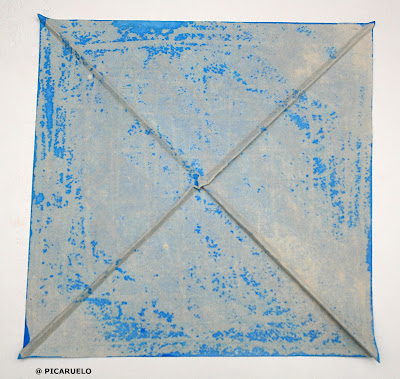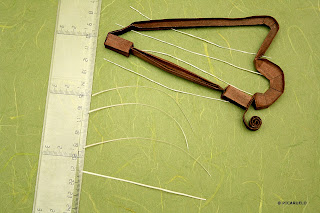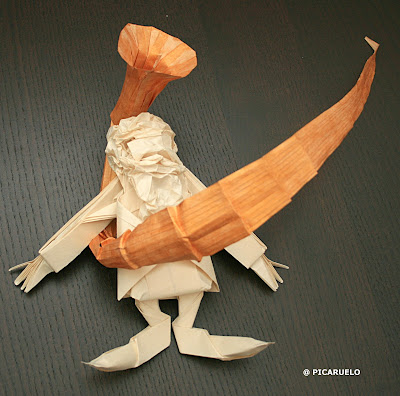January 2014. My smaller sister's birthday is coming. For a long time I have been thinking about giving an origami present to each member of my direct family, five brothers and sisters including myself, father and mother. I fold a tessellation and throw it to the dustbin, flowers but I don't like them. ¿an animal? Too conventional. I fold a Joisel's dwarf with double tissue paper but the end result is horrible.
Suddenly I think about the wonderful Eric Joisel's Exhibition in Zaragoza in 2013. He used a paper called kozo to fold most of his latter models. I find it and fold another dwarf. Yes, this time, I'VE GOT IT. It is a beauty worth to give as a present. I had already though about giving my next brother a Joisel's violinist so I have two of the presents solved. The project begins to take form in my mind.
I fold a clarinet, glue it to the dwarf and voila, the 7th of February I give it to my sister. It is a complete success. In a private letter I explain her the project and ask her to keep silent about it.
The same day is also the birth of my blog PICARUELO'S ORIGAMI. I pretended it to talk about different origami subjects but for now due to lack of time has been devoted to this project.
I have one month left for the next birthday. I start my second musician, the violinist. The first one was harder because I didn't know the paper and how to work with it, In spite of it, the last days before the 5th of March are very busy designing a violin, writing the blog and shaping the dwarf. The 5th of March I give it to my brother. Another success. This dwarf is still one I specially like.
One month left. The 18th of May. My father. I decide to go for the saxophonist. The hardest part is the instrument. After a one long day work I find a solution. I fold a proof model. It will work. Desperately looking for gold like paint I discover the acrylic gold colour. Just in time the 18th of August I give the present. The project begins to be clear for the rest of the family. Even so, I and the three dwarf owners keep silent.
Finally I enter a period of relative calm. My next date is the 25th of July. The bad thing is that after that date, there comes the 26th of July and then the 1st of August. This time I will work in parallel folding the three models at the same time. This is how the flautist and the bandoneonist for my older sister and brother and the cymbal player for me come to life.
The schedule becomes very tight but in a final sprint I finish on time.
Only one left, my mother the 23rd of August. She already knows she will have her own dwarf. In spit of the summer holidays I manage to fold it on time. It is one of my preferred dwarves, the bass player:
This is how I came to the 23rd of August with seven dwarves and no more compromises. I could spend some time thinking about new things. After folding dwarves from 5 different CPs I had enough experience to try my own models. I already knew the box pleating technique from the wonderful Robert Lang's book, 'Origami Design Secrets' . My first design was the drummer a model I like more and more as days go by:
After my first new dwarf I go after my second goal, a woman. This is how I design my Milady. After adding a trombone she becomes the trombonist:
The months have run away fast. It is March 2015. I have two new deadlines, two exhibitions organised by the EMOZ, the Zaragoza Origami Museum. At the end of June there will be an exhibition about Spanish folders and creators in Zaragoza and in April there will be another exhibition in the Printer Museum in Madrid. It is a good chance to exhibit the whole band. In the end I choose Madrid, my city. In just one month I have to design and fold two new musicians, the sousaphonist and the harpist.
I give the sousaphonist to my older son. He contributes to the model folding the little crane standing on top of the left shoe:
I give the harpist to my younger son who also contributes to the model folding the blue 'pajarita' standing beside the harp:
I spend the night of the 24th to the 25th of April at home photographing the complete band.
This is the result of all this work:
During this year I have had the help of a lot of people, the majority origamists. Thank you to all of them. I also want to thank the people that have created or deduced some of the models I have used for my band:
And of course, infinite thanks to the great master Eric Joisel, my great inspiration to launch this project.
From the 25th of April the band is on exhibit in the Printer Museum in Madrid. For several months it will receive the visit of many people. Even the Madrid public television, Telemadrid, made a visit to the exhibition and immortalised the saxophonist. The 30th of August the dwarves will return to their owners waiting for another opportunity to join again.
 |
| Preparing the family photo with a big blue sheet as background |









































































